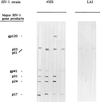HIV type-1 infection of the cotton rat (Sigmodon fulviventer and S. hispidus)
- PMID: 9826704
- PMCID: PMC24377
- DOI: 10.1073/pnas.95.24.14355
HIV type-1 infection of the cotton rat (Sigmodon fulviventer and S. hispidus)
Abstract
Cotton rats (Sigmodon hispidus and S. fulviventer) are susceptible to many viruses that infect humans (e.g., poliovirus, respiratory syncytial virus, influenza virus, adenovirus, and parainfluenza virus) and have been influential in developing therapeutic clinical intervention strategies for many viral infections of man. This study set out to determine whether cotton rats are susceptible to infection with HIV type 1 (HIV-1). Results indicate that HIV-1 does infect the cotton rat and S. fulviventer is more susceptible than S. hispidus. The virus was passaged from animal to animal for a total of three serial passages; but HIV replicated poorly in vivo, was only detectable as proviral DNA, and never exceeded one provirus per 1.8 x 10(5) cotton rat peripheral blood mononuclear cells. Infection induced a distinct and characteristic anti-HIV antibody response that, in some animals, included neutralizing antibodies, recognized all of the major HIV-1 antigens and the antibodies lasted out to 52 wk post-infection. Neonate S. fulviventer were not more susceptible to infection than adults. In vitro culture studies produced indirect evidence of viral replication by detection of viral gag gene RNA in reverse transcriptase-PCR assays on viral culture supernatants. Collectively, these results indicate that HIV-1 can replicate in a nontransgenic rodent and that this system may have potential as an animal model for HIV-1 infection if viral replication rates can be improved in vivo.
Figures
Similar articles
-
Pathogenesis of human parainfluenza virus 3 infection in two species of cotton rats: Sigmodon hispidus develops bronchiolitis, while Sigmodon fulviventer develops interstitial pneumonia.J Virol. 1991 Jan;65(1):103-11. doi: 10.1128/JVI.65.1.103-111.1991. J Virol. 1991. PMID: 1845878 Free PMC article.
-
Definition of cotton rat immunoglobulins: sigmodon species differ in expression of IgG isotypes and production of respiratory syncytial virus antibody.Immunology. 1996 Jul;88(3):323-30. doi: 10.1046/j.1365-2567.1996.d01-678.x. Immunology. 1996. PMID: 8774346 Free PMC article.
-
Dynamic Shifts in the HIV Proviral Landscape During Long Term Combination Antiretroviral Therapy: Implications for Persistence and Control of HIV Infections.Viruses. 2020 Jan 25;12(2):136. doi: 10.3390/v12020136. Viruses. 2020. PMID: 31991737 Free PMC article.
-
Viral load in peripheral blood mononuclear cells as surrogate for clinical progression.J Acquir Immune Defic Syndr Hum Retrovirol. 1995;10 Suppl 2:S51-6. J Acquir Immune Defic Syndr Hum Retrovirol. 1995. PMID: 7552513 Review.
-
Cotton rats (Sigmodon hispidus): an animal model to study the pathogenesis of measles virus infection.Immunol Lett. 1999 Jan;65(1-2):47-50. doi: 10.1016/s0165-2478(98)00123-0. Immunol Lett. 1999. PMID: 10065626 Review.
Cited by
-
Cotton rat Sihi-M3 is a minimally oligomorphic Mhc I-b molecule that binds the chemotactic peptide fMLF under stringent conditions. Evidence that positive selection drives inter-species diversity of residues interacting with the termini of short peptides.Immunogenetics. 2003 Sep;55(6):389-94. doi: 10.1007/s00251-003-0593-6. Epub 2003 Aug 27. Immunogenetics. 2003. PMID: 12942207
-
Identification and characterisation of the CD40-ligand of Sigmodon hispidus.PLoS One. 2018 Jul 27;13(7):e0199067. doi: 10.1371/journal.pone.0199067. eCollection 2018. PLoS One. 2018. PMID: 30052641 Free PMC article.
-
Expression of Human CD4 and chemokine receptors in cotton rat cells confers permissiveness for productive HIV infection.Virol J. 2009 May 14;6:57. doi: 10.1186/1743-422X-6-57. Virol J. 2009. PMID: 19442298 Free PMC article.
-
Modeling Human Respiratory Viral Infections in the Cotton Rat (Sigmodon hispidus).J Antivir Antiretrovir. 2014 Mar 3;6:40-42. doi: 10.4172/jaa.1000093. J Antivir Antiretrovir. 2014. PMID: 25635205 Free PMC article.
-
Nitric oxide production and nitric oxide synthase type 2 expression by cotton rat (Sigmodon hispidus) macrophages reflect the same pattern as human macrophages.Dev Comp Immunol. 2009 May;33(5):718-24. doi: 10.1016/j.dci.2008.12.004. Epub 2009 Jan 18. Dev Comp Immunol. 2009. PMID: 19154756 Free PMC article.
References
Publication types
MeSH terms
Substances
Grants and funding
LinkOut - more resources
Full Text Sources
Other Literature Sources
Medical


